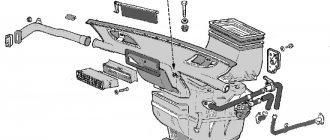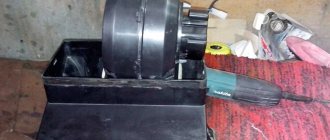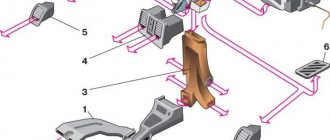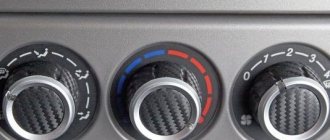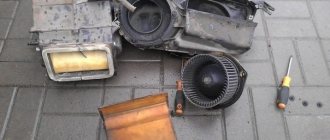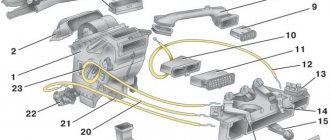On the VAZ 10th family, which includes the VAZ 2110-2112 models, the designers used an electronically controlled interior heating system, thanks to which the temperature set by the driver is maintained automatically.
On the VAZ-2110, instead of a manual heater control mechanism with a cable drive of the main elements - the coolant shut-off valve and dampers, an automatic heater control system (AHC) controller with a temperature sensor and a gearmotor that regulates the position of the dampers are used.
In such a stove, the valve for shutting off the antifreeze supply is no longer used, and the adjustment of the heater operating mode - “heating” or “ventilation” - is carried out by a central damper, which directs the air flow through the radiator or bypassing it.
How malfunctions manifest themselves
The automatic temperature maintenance system used on the VAZ-2110 is more convenient in terms of control, since the automatic control system does everything independently, but is less reliable than a mechanical cable drive. Moreover, problems are caused by the electronic and electrical components of the stove - the controller, temperature sensor and micromotor gearbox, the central damper, which regulates the air supply to the cabin from the outside.
Problems with the operation of the VAZ-2110 heater related to the damper:
- lack of temperature control (only hot or cold air comes from the stove) regardless of the position of the handle on the controller;
- insufficient air heating (even when setting the handle to the maximum temperature);
- squeaks, knocks and extraneous noises after setting the temperature.
The cause of such problems is the central damper of the VAZ-2110 stove, which is adjusted by the controller through a gearbox. The design of the stove includes another damper - air distribution into zones. It is controlled using a handle mounted on the central air supply deflector into the cabin, so malfunctions with this part are rare.
About replacing seats
The seats on the VAZ 2112 cannot be called comfortable. This is especially noticeable on long trips. So, at the first opportunity, drivers put seats from other cars on the “two-wheeler.” As a rule, Skoda Octavia acts as a “seat donor”.
It is impossible to install the seats from this car on a VAZ 2112 in the garage, since serious adjustment of the fasteners and welding are required. There is only one option: use the services of specialists with the appropriate equipment.
vote
Article rating
Features of the design of the VAZ - 2110 stove damper
Note that VAZ-2110 of different years of manufacture uses heaters that differ in design:
1. Old-style stove damper
Old heaters use two central dampers, one of which blocks the flow of air into the cabin from the outside, and the second one redirects the air flow to the heater radiator or bypasses it. They are interconnected by drives and opened by a micromotor gearbox.
2. New sample
In the new type of stove there is only one central damper and it is connected by a drive to the gear motor directly, and not through a lever.
3. Under the “Euro” panel
Structurally, such a stove does not differ from the new type of heater, but in it the damper for distributing the air flow into zones is controlled by another micromotor gearbox.
It is easy to visually distinguish the stoves by the location of the heater fan. In the old-style interior heater, the fan is located horizontally, while in the new model, it is positioned vertically. Their gearmotors are also different.
Weak warm air supply
The air flow is warm enough, but the pressure is insufficient. In such a situation, the following malfunctions are possible:
- The cabin filter is dirty. In this case, you need to clean it from dust with a vacuum cleaner. If this cannot be done, then it is better to replace it.
- The stove radiator is clogged. In addition to dust, both insects and leaves create plugs. Small particles can be blown out using compressed air. To remove large dirt, you need to remove the grill and wash it.
Insufficient air pressure may be due to a leaking radiator. This problem is determined very simply - if you constantly add antifreeze or antifreeze, then pay attention to the condition of this unit in the car. To eliminate this malfunction, you will need to gain access to the radiator and remove it along with the heater.
The practice of soldering the heatsink is unreliable. It is better to install a new part so as not to disassemble half of the front end later.
Causes of malfunctions
Depending on the design of the stove, the damper may cause a disruption in the efficient operation of the heater for the following reasons:
- deformation;
- wear of seals;
- deterioration or damage to control levers and rods;
- skew.
Deformation is a problem with old-style heaters. The first dampers of the VAZ-2110 stove were equipped with plastic elements that bent under the influence of temperature. Because of this, even when completely closed, cold air from outside leaks in and mixes with the heated air, and the efficiency of the stove decreases. Subsequently, the designers replaced the plastic flaps with aluminum ones and the problem with deformation disappeared.
To ensure tightness, the dampers have seals that reduce air leakage. Initially, foam rubber seals were used, which quickly wore out and became damaged. Later, foam rubber was replaced with rubber, but this only extended the service life of the seal; over time, the rubber ages, cracks and collapses.
On old-style stoves, rods and levers may break. On new heaters, there is another problem - wear on the edges of the square end of the gearbox, with which it is inserted into the groove made in the damper axis. As a result, the limit switch bypasses the groove, and the heater damper jams, although the gearmotor operates. The misalignment occurs due to the displacement of the damper axis in the mounting holes of the housing. Because of this, the damper warps and jams when opening.
Components and processes of the VAZ-2112 heater
- electro-pneumatic valve;
- housing with the air intake of the heating system, consisting of front and rear parts;
- water-reflective air intake flap;
- valve for controlling the recirculation damper;
- recirculation damper on the air intake;
- damper on the stove channel;
- stove control damper;
- radiator and its casing;
- fittings on the steam exhaust and supply hoses;
- stove electric motor in the housing and fan;
- support platform for the lever from the heater control damper drive and the lever itself;
- micromotor gearbox with damper drive;
- resistor;
- cover from the stove casing.
Repair and restoration of the stove damper
The deformed heater damper of the VAZ-2110 cannot be repaired; it only needs to be replaced. In this case, it is better to purchase a replacement metal part that is not so susceptible to temperature effects.
Whatever heater is installed on the VAZ-2110, to carry out repair work, the heater must be completely disassembled. In this case, the process of dismantling and disassembling depends on the design of the stove.
A positive aspect of the heater design on the VAZ - 2101 is its location - to get to it and the dampers you can from the engine compartment and you don’t have to remove the front panel.
Disassembling an old-style stove
For example, let's look at how to disassemble an old-style heater:
- Remove the terminal from the battery.
- We remove the windshield wipers, the seal, remove the air intake near the windshield (“jabot”) from the car, in the process you will need to disconnect the windshield washer nozzle tubes.
- We dismantle the insulation that separates the stove body from the engine compartment.
- We remove the gear motor.
- We divide the housing of the stove and air filter into two halves. To do this, unscrew the coupling bolts around the perimeter of the housings and remove the mounting brackets.
- Disconnect the fan power wires.
- Remove the outer half of the air filter and heater housing (along with the fan).
- We dismantle the inner part of the fan housing.
After this you will have access to the dampers. If you are only planning to repair or replace the heater dampers, there is no need to drain the antifreeze, since the heater radiator will remain in place and will not be removed.
Before removing the dampers, carefully inspect and remember their position and the way they are engaged. Further actions depend on the nature of the damage. Deformed damper parts cannot be repaired and only need to be replaced. As for damaged rods and levers, try to repair them or simply replace them. The damaged seal is replaced.
When assembling the stove, pay special attention to the engagement of the dampers. Do it as it was before disassembly, otherwise the dampers will not work correctly, which will affect the performance of the heater.
Disassembly and repair of a new type heater
The new model stoves are disassembled differently:
- disconnect the battery terminal, drain the antifreeze;
- dismantle the frill and insulation;
- disconnect the power wires of the fan and micromotor gearbox;
- unscrew the fasteners that secure the stove body to the body;
- disconnect the coolant supply pipes to the heater radiator;
- We remove the heater from the car along with the filter housing.
After this, we disassemble the stove body, dividing it into two halves, after first disconnecting the air filter housing and removing the mounting brackets. Next, we change or repair the damper, assemble the heater and install it on the car.
Note that the general algorithms of work are indicated above, but in reality, dismantling the stove is not so easy, since many fasteners are located in hard-to-reach places, sometimes you have to disconnect or remove elements that make it difficult or interfering with the removal of the unit.
Video: Why the VAZ 2110 stove does not heat up. Modification of the damper.
- 1 The main reasons for poor operation of an electric furnace
- 1.1 What does extraneous noise in the heater motors indicate and what is its role in the overall scheme
VAZ 2110 heater diagram
As you know, the main functional purpose of a car heater is to supply warm or cold air inside the cabin. In order to have a practical opportunity not only to identify a malfunction, but also to eliminate it, you need to know how the VAZ 2110 stove circuit is designed. After all, there are different types of possible malfunctions and there can be both problems in the electrical circuit and in one of the elements of the stove itself. For a VAZ 2110, the heater diagram and knowledge of it will make it easier for the motorist to find a break and repair the heater.
Let's sum it up
The high-quality functioning of the heating system of a vehicle is the main factor that affects the comfort and convenience of the interior. Problems with its operation during the cold winter periods force drivers to carry out urgent repairs and checks of the heating system.
There can be many reasons why the VAZ-2110 stove does not work or does not heat well. The main thing is to understand the technical features of the car’s heating system in order to narrow down the search for a fault as much as possible. Almost all dozens of causes of poor-quality interior heating can be eliminated with your own hands without significant financial investments.
To prevent heater breakdowns at inopportune times, monitor the car’s heating system and carry out regular preventive inspections and diagnostics. Experts recommend diagnosing the vehicle heating system at least twice a year. Only proper operation of the heater and constant high-quality care of it will guarantee its uninterrupted operation at any time of the year.
The main reasons for poor operation of an electric furnace
VAZ 2110 stove diagram
Before you can directly begin to find a solution to a problem, you need to be able to identify it quickly and effectively. First, it is advisable to consider the general structure of the furnace. So, the heater furnace consists of the following components:
- mounting block fuse;
- incendiary lock;
- ignition switch together with its unloading relay;
- a special switch that regulates the operating mode of the furnace electric motor;
- additionally built-in resistor;
- stove motor;
- heated rear window of the car, which contains a heater adjustment button with a light indicator;
- a special functional element for heating glass.
VAZ 2110 stove wiring diagram
One of the reasons for the malfunction of the electronic circuit of the furnace may be the lack of functional activity of the heater electric motor at both low and high speeds. In this situation, you must proceed as follows:
- First you should make sure that the fuse has not accidentally blown;
- If a blown fuse is detected, it will urgently need to be replaced with a new one.
Repair of the electrical heating system of the VAZ interior
— the fan electric motor does not rotate at any position of the rotation speed switch: most likely, the electric motor itself has failed (the brushes have worn out), or there is no voltage at terminals 2 (ignition switch malfunction) and 4 connectors of the mounting block (fuse F4 has blown), it is also worth checking the mass of the engine itself (it should be no more than 3 ohms). The electric motor on the “classic” VAZ 2101 - 2107, as well as on the VAZ 2121, as well as on the VAZ 2121 “NIVA”: installed in the cabin, immediately behind the heating radiator; in VAZ 2108, 2109, 21099, 2113, 2114, 2115 - under the hood, in the compartment behind the engine shield; in VAZ 2110, 2111, 2112 and Priora 2170 - also under the hood, behind the plastic protection, on Kalina - in the cabin, under the dashboard.
- maximum fan rotation speeds, according to the diagram, are without a switch, and if only the minimum and average speeds do not work for you, then the reason must be looked for in the speed switch button or in additional resistors (values in the diagram);
- sometimes, when you turn on the stove, you hear a very loud noise, high tones (squeaking) and there is no proper airflow. This indicates a malfunction of the heater electric motor itself (jamming of the impeller or armature bearings), in this case either replacement or disassembly and lubrication will help (not recommended, as it helps for a short time);
Stove design
This unit includes several devices. The radiator is the main element of the stove - it heats the air entering the cabin. It is located under the hood. The next component is the air distributor, equipped with special pipes that run through the cabin of the 2110.
If we compare the “ten” with previous models, an important innovation has appeared in its heating system - an evaporator (the diagram includes it in the list). The device is installed in an air conditioning system. Not all owners know about its existence, since it rarely fails.
To control the operation of the heater, an SUAO unit is installed in the VAZ 2110 car, which is called a controller in the technical operating manual. The unit works in conjunction with a temperature sensor in the cabin; it is also called a ceiling sensor. The sensor reports the temperature to the unit, then this indicator is compared with the set temperature on the handle. If the indicators differ by more than 2°, warm or cooled air is supplied to the VAZ 2110 interior.
It’s worth taking a closer look at the handle, or more precisely at its extreme positions – MAX and MIN. If the heater knob is set to one of these indicators, heat is supplied without the operation of the temperature sensor in the cabin. The scheme includes all of the above elements.
The device of the “tens” heater includes another unit - a gearmotor, which is responsible for opening and closing the damper. The miniature electric motor performs an important task in the operation of the heating system, as evidenced by the diagram. If the gearmotor is faulty, the system will only produce cold or hot air. If the gearmotor fails when the damper is closed, the system will stop functioning. We have described the main components of the VAZ 2110 heater; the diagram contains a more detailed list.
Let us highlight the main components of the system:
- Radiator.
- Air distributor.
- SUAO block.
- Ceiling sensor.
- Lever.
- Damper.
- Gearmotor.
Radiator
In the heating system, a radiator is installed for heating, which enters the VAZ 2110. It is also called a heat exchanger. Heating is carried out by the heat of the antifreeze. This component is connected to the engine cooling system by pipes and hoses. Antifreeze constantly circulates through the heat exchanger of the stove. The damper, based on the commands of the unit, directs the incoming air to the radiator or directly into the passenger compartment. If the heater damper is in an intermediate position, then one part passes through the heat exchanger, and the second bypasses the radiator. If we compare this part of the stove with previous generations of the VAZ, it has a number of useful improvements, as the diagram demonstrates.
SUAO and ceiling sensor
These components of the VAZ 2110 heater are connected and operate according to the following principle:
- The sensor determines the temperature inside the car;
- This data is sent to the SUAO block;
- The block compares the temperature with the position set on the handle of the VAZ 2110 stove;
- After comparison, the position of the damper changes or remains the same - it depends on the indicator;
- This way the temperature in the cabin is controlled;
- If the heater handle is set to MAX or MIN, then the data from the ceiling sensor is not taken into account.
All these actions are demonstrated by the diagram. The block is a set of microcircuits; the normal operation of the stove depends on its serviceability. Both the sensor and the control system can be replaced.
see also
Damper and gearmotor
The heater gear motor changes the position of the damper, due to which air is supplied to the cabin. This component is controlled by the control system block. If the device is faulty, the damper will not move. The unit is a miniature electric motor. When it breaks, it is usually replaced, since repairing it will be problematic. This also applies to the damper. The diagram shows the connections between the gearbox and the block.
Temperature does not change
In this case, you fail to adjust the internal climate, and the result is sometimes both unbearable heat and cold. The reason for this may be the following:
- The control unit does not receive information from the temperature sensor. This measuring device is installed in the ceiling next to the lampshade. To check its functionality, turn the adjustment knob to its extreme position (several times). If there is no reaction or it appears in the extreme position, it is necessary to change the sensor.
- Damper failure. It is quite possible that the damper is simply jammed and is now unable to turn. The reason for this is oxidation of the mechanism fastenings. It is possible to get to the damper only from the engine compartment. Initially, you need to remove the deflectors, bend the antennae, and only then try to move the element.
Diagram and explanations for it
Below is a diagram of the parts that make up the heater system of a VAZ 2110 car.
It is worth saying that recirculation operates in the “tens” heater system, as the diagram tells us. In simple words: air circulates inside the VAZ 2110, and is not taken from the street. The main advantage is that dust and unpleasant odors do not enter the cabin from the street. There are more disadvantages to such a stove system - the glass quickly fogs up. It is recommended to open windows more often if the outside temperature allows it. Air stagnation negatively affects the health of the driver and his companions. The heater gear motor can rarely be repaired, so it should be replaced immediately.
For VAZ 2110 owners who want to modify the heater system or carry out electrical repairs, an automatic control circuit will be useful.
Why is it impossible to change the heating temperature?
You can often observe a situation in the cabin 2110 2112 when the stove does not react in any way to the position of the temperature regulator, while the air temperature can be constantly low or constantly high. This is a sure sign that one of the electronic components has died. Let's check it all like this:
- Interior temperature sensor. The stove controller receives information from the temperature sensor. It is located on the ceiling, near the interior lamp. The sensor is guaranteed not to work if the stove responds to the temperature control knob set to the extreme right position. Otherwise, we are looking for a fault in the controller itself.
Advice from auto mechanics
To tune the VAZ heating system, its circuit diagram is studied. The system can be modified to block the air flow to the rear of the car using foam. The factory thermostat is also being replaced with an analogue one with 6 holes. In this case, the temperature in the cabin will remain longer, and the stove will heat better. Another way to modify the standard 2110 heating system is to install a plug for the deflector.
In order for the stove to serve longer, it is recommended to follow the rules of its operation.
If your car has air conditioning, it should only be turned on in wet weather. In winter, the stove turns on and directs the air onto your feet or onto the glass.
To ensure good operation of the heater, the nozzle is raised above the lining. Before starting the stove in winter, it is recommended to clean the glass from moisture.
